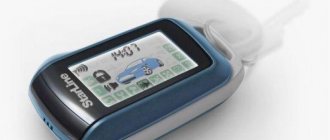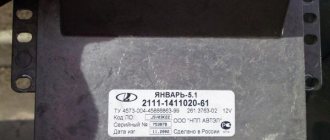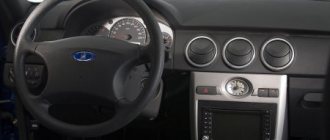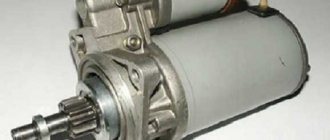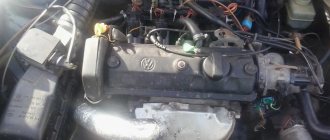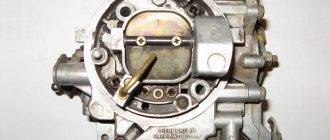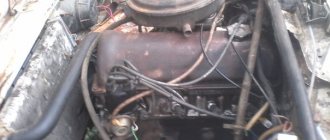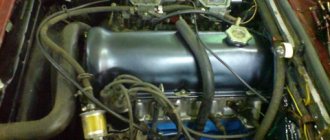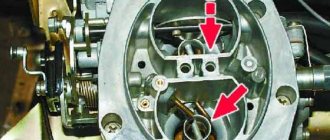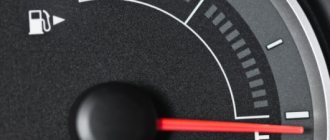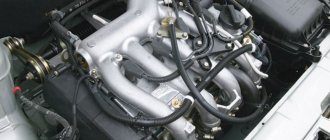If your car engine does not start (if the injector does not start, and also if the diesel engine does not start), then externally this can manifest itself in different ways. Let's discuss possible options (see video below).
First option: you turned on the ignition, BUT not a single sensor on the instrument panel lights up. Possible reasons:
– the battery is completely discharged;
– there is no contact between the negative wire of the battery and the body: either the terminal is not tightened well, or the wire has oxidized exactly where it connects to the body. You need to strip the end of the wire or tighten the terminal;
– the main fuse has blown.
Second option: you turned on the ignition, all the sensors on the instrument panel lit up, BUT the starter does not turn. Possible reasons:
– the battery pole pins are oxidized or the terminals are poorly tightened, resulting in poor contact. You need to clean the pole pins and tighten the terminals;
– the negative wire of the battery on the body or engine has oxidized, as a result – a transition resistance appears, which prevents the starter from working. The problem will be solved if this wire is stripped or crimped;
– The battery is half discharged. If you try to turn on the starter, this will manifest itself as the relay clicking, and the starter will not be able to turn the crankshaft. In addition, the battery light is dim;
– the engine does not start if there are any malfunctions with the starter: for example, the contact plates of the retractor relay have burned out, the fuse has blown, the brushes have become unusable, and, possibly, the starter relay has become unusable.
Third option: you turned on the ignition, everything works fine, the starter turns the crankshaft properly, BUT the engine does not start. Possible reasons:
– there is no fuel in the tank;
– there is a malfunction in the ignition system. It is necessary to check the operation of: the ignition coil, all elements of the ignition system;
– check the serviceability of the fuel pump: if you disconnect the fuel supply hose to the carburetor and turn the starter, then there should be a fuel pulsation in a properly functioning fuel pump (watch the video here);
– the fuel filter is clogged (if fuel does not flow, dry spark plugs will also confirm this). You need to remove the fuel filter and try to start the car without it. The clogged filter is replaced with a new one;
– often the carburetor engine does not start when hot. This occurs due to the over-enrichment of the fuel mixture, what needs to be done in such situations is described here;
– a cold engine does not start due to a poor air-fuel mixture: adjusting the VAZ carburetor, how to adjust the idle speed of the carburetor
– air penetrates through one of the gaskets, which are located 1) between the carburetor and the intake manifold, 2) between the intake manifold and the engine head.
Video: VAZ 2109 will not start!
If the video doesn't show, refresh the page or click here
1200 rub. for the photo report
We pay for photo reports on car repairs. Earnings from 10,000 rubles/month.
Write:
A car may not start for many reasons. Moreover, drivers are faced with a problem when the car does not start in cold weather, when cold, when hot, after major repairs, and so on. This problem affects both gasoline (injection and carburetor) and diesel engines.
Basically, the car will not start if : a discharged battery, problems in the fuel supply system, dirty filters, etc. This situation can happen not only with a car whose owner does not care about the technical condition of the car, but also with a car owner who regularly takes care of his “iron horse”. Next, we will consider the previously listed reasons in more detail, and we will figure out what can be done in this or that case.
Popular reasons
We list the most common reasons why a car refuses to start, as well as brief tips on what to do in a particular case:
- Problems with the battery . Battery discharge is possible when the car is left idle for a long time in a garage or in a parking lot. Especially if the air temperature is negative. In this case, the battery may be discharged by 30-35%. There are several ways out of this situation. First, you need to turn on the high beams for a while (2-3 seconds) in order to activate the electrolyte. It is also worth checking whether the terminals on the battery are oxidized and whether there is good contact on them. However, it is best to remove the battery and charge it when parked for a long time.
- Fuel supply system . If the starter works, but the engine does not start, one of the reasons for this is a faulty fuel pump. It is necessary to measure the pressure in the fuel line. This will give an idea of the condition of the pump, filter and other system components. The fuel hose may also be damaged. This can be determined visually by the drips and smell of fuel. The solution is to replace the filter or hose, repair or replace the fuel pump.
- Spark plug . One reason may be soot deposits on the spark plug. In turn, the reason for this is the formation of an incorrect fuel mixture. Another reason is oil on the spark plug, which may be a result of its level being too high. Other reasons are varnish or slag deposits, wear of the electrode or spark plug connector, and so on. The solution is to unscrew, check, wipe or dry the problematic spark plug. Replace it if necessary.
- Air filter . A clogged filter can also cause the engine to not start. It is necessary to check its condition and replace it if necessary.
- Circuit breakers . It is necessary to immediately check three relays with fuses - the computer, the fan and the fuel pump.
- Starter . You can check its operation by applying voltage to the contacts directly from the battery. If it does not spin or the bendix does not eject, it is necessary to dismantle the starter and replace the faulty part.
Option
When the engine is cold, it starts without problems. It warms up and works fine. If you turn it off until it cools down, it won't start. Only if you press on the gas at the same time. And at the same time, the engine does not pull and its operating sound is unusual.
We checked all the sensors, oil level, fuel pump, even went for diagnostics, but didn’t find the problem.
After that, we changed the fuel filter and the fuel pump with a mesh. Everything worked fine. But not for long.
At first the car jerked, the revolutions began to drop. You turned off the engine, and it started only after a couple of hours.
Car won't start in cold weather
If all parts of the engine in the car are in good working order and working normally (this includes a well-charged battery, filled with winter oil, serviceable spark plugs, new or just clean fuel and air filters, intact insulation on the wires, a working distributor, no water in the tank and wiring), then it should start without problems in temperatures down to -15°C (although for many domestic cars the critical temperature may be higher). In more severe frosts, it is necessary to use additional techniques and means. You can find out about them in tips for starting the engine in cold weather here.
Car won't start when cold
Also, the engine often stalls if it is cold. The main reasons why a car will not start when cold are the following:
- low battery charge;
- incorrectly selected engine oil (too thick);
- incorrectly set valve clearances;
- malfunction of the engine temperature sensor;
- malfunction in the mass air flow sensor;
- XX valve clogged;
- dirty throttle valve;
- faulty spark plugs, damaged high-voltage wires or ignition coil;
- air leak into the fuel system;
- malfunction in the pressure regulator in the fuel system;
- low fuel pressure (usually due to a clogged fuel filter);
- malfunction of the fuel pump;
- low quality fuel.
You will find detailed information on why the engine does not start when cold and tips on how to deal with the problem in the article devoted to this topic.
Car won't start when hot
Also, many drivers encounter a problem when the car does not start when hot. This situation has no fewer reasons than the previous one. However, the following can be distinguished:
- failure of the coolant temperature sensor;
- depressurization of fuel injectors;
- for diesel engines - malfunction of the high pressure fuel pump (HPF).
Previously, we examined in detail the reasons why the car does not start when hot. We recommend that you read the article, which provides detailed information that will help you start the engine.
Petrol engine car won't start
What to do if the car won't start
According to statistics, there are much more passenger cars with gasoline engines. The causes of problems with starting gasoline and diesel engines are significantly different. There are also differences between carburetor and injection engines. Therefore, we will consider each of these types separately.
Carburetor engine does not start
We list the main reasons why a carburetor engine may not start, as well as methods for eliminating them:
- completely or partially discharged . In the first case, when you try to start, not a single light on the dashboard will light up, and the starter will not turn over. In the second case, there is not enough energy from the battery. to start the engine. A low charge will be indicated by the arrow of the device or the corresponding indicator on the dashboard. In any case, you need to check the voltage at the battery terminals with a multimeter. If it is below normal, you should either “light it” from another car, or remove and charge the battery.
- The starter does not work . There can be two types of reasons - mechanical or electrical failure. The first includes wear of brushes, bearings, jamming of the drive gear on the rotor splines, and wear of the freewheel. Electrical - loss of contact, beating of the rotor, short circuit of the windings, burning of the working surfaces of the contact bolts and the closing plate when large currents pass through the contact point. We discuss all this in detail in the material “Starter malfunctions”. Therefore, it is necessary to diagnose the node. We'll talk about this below.
- Problems with the carburetor . There can be a lot of them. To test this hypothesis, certain steps must be taken. You can read more about carburetor malfunctions using the example of the Solex model, popular in our country, separately.
- Failure of spark plugs . You must follow the steps described in the previous section.
Injection engine does not start
Problems starting an injection engine
Some problems with starting an injection engine are similar to its carburetor counterpart. Among them are problems with:
- battery;
- starter;
- fuel filter;
- spark plugs;
- wiring and fuses.
When checking an injection engine, you need to pay attention to:
- Fuel pump . If it does not turn on, you need to check its contacts, as well as the contacts on the coolant sensor. Most often the problems lie in the wiring. In addition, you need to check the fuel filter. As a rule, when a pump fails, it is replaced.
- Camshaft and crankshaft position sensors If they fail, they need to be replaced.
- Spark at the injector . It is necessary to diagnose it, look at the operation of the ignition module and controller.
Happening
The day before the VAZ 2109 injector stopped starting, everything was fine. Today the car just stopped on the road. You turn the ignition and hear the relay click, but you don't hear the fuel pump running. In this case, the fuel sensor does not work, but the starter turns.
We decided to try to start in half an hour. She started up. But it stalled after 10 seconds. You try to start it again, the above symptoms repeat. What do you think is the matter?
The wiring may have broken. Take a special look at the mass coming from the fuel pump. It may break off near the parking brake lever.
If everything is in order there, look at the contacts of the fuel pump relay. They may burn. Then look at the fuse terminals.
If everything is in order, and you even swapped the relays, rang the wiring and it was to no avail, then run the wires directly to the fuel pump. If it doesn't work, then it needs to be replaced or repaired.
You drove all day and everything was fine. In the evening, after the car had been sitting for a couple of hours, we tried to start it to no avail. The engine seems to catch on, but there is no sense. What's the first thing you do?
Look at the candles. They are wet. You buy new ones, install them, but the problem remains.
Then you check the timing belt, battery, fuel pump, whether there is gasoline - everything is in order. Then they made sure there was a spark. And now you are wondering what to do. And this is what needs to be done.
You need to check the crankshaft position sensor. Or rather, its wire is near the terminal. He is often interrupted. And the fact that a spark passes is because the wire twitches and hits the contact. As a result, the spark jumps.
Diesel engine won't start
A diesel engine works differently than a gasoline engine, so it has its own problems when starting. The most popular of them:
- Compression drop in cylinders . The consequence of this is a low temperature, which prevents the fuel mixture from igniting. The reason for this is most often the wear of the cylinders and o-rings. Restoration requires a major overhaul of the engine.
- Problems with glow plugs . This is especially true in cold weather. Usually, if two or more spark plugs fail, it is impossible to start the engine when cold. However, there may be problems with the spark plug relay and the spark plug electronic control unit. To eliminate the breakdown, it is necessary to check both the spark plugs and their relays.
- Problems in the fuel system . There may be several of them. The first is clogged fuel injectors. It can be complete or partial. In the first case, the engine will not work at all, in the second it will “sneeze” and “puff”. If everything is fine with the injectors, it is necessary to conduct a complete inspection of the fuel system (from the fuel pump to the injectors).
- Waxing of fuel . This problem is relevant for the cold season. When exposed to frost, the fuel thickens, and the paraffins it contains clog the fuel filter. The way out of the situation is to clean the filter and use winter diesel fuel.
Problems with the starter (won't turn or click)
As we discussed above, it is impossible to start the engine with a faulty starter. There may be several reasons for its failure. Let's consider the main ones:
| The starter cranks the engine too slowly . | The reasons for this may be insufficient battery charge, ignition too early, or excessive viscosity of the engine oil. |
| The starter overcomes the increased internal mechanical resistance of the engine. | The reasons may be changes to the engine design, poor contact or malfunctions in the power unit, damage to the electric motor, or mechanical problems in the engine being started. |
| The starter cannot crank the engine . | The reasons may be poor contacts on the battery, a situation where the gear does not engage with the crankshaft, clutch slipping, or engine blocking. |
| The starter rotates, but the crankshaft does not rotate . | There can be many reasons. It is necessary to check the wear on the teeth of the flywheel and clutch, and check the starter itself for mechanical wear. It is also possible that the starter may be installed incorrectly during repairs. |
| The starter does not rotate, its relay does not click . | A possible reason is the low level of electrolyte in the battery or its low density. The retractor coil of the electromagnetic relay or its rod may also fail. |
| The starter does not rotate, its relay clicks . | You also need to check the electrolyte level in the battery and its density. In addition, there may be poor contact of the starting circuit or a malfunction of the power unit. |
It is also worth considering separately the situation when, when you turn on the ignition, a click is heard, but the starter does not rotate. Possible causes of the malfunction:
- No voltage to the relay. It is necessary to check the wiring and contacts of the control circuit.
- Burnt relay contacts. If necessary, clean them or replace the device.
- Insufficient battery voltage. In this case, it needs to be charged or replaced.
- A characteristic metallic clang from the place where the coupling is located. The cause may be mechanical damage to the clutch or flywheel. It is necessary to visually inspect these parts for cracks, dents, and correct shape.
If the car immediately stalls after starting
Sometimes it happens that the car can be started and everything seems to be fine. However, after working for a few seconds, it stalls. There may be several reasons for this:
- Running out of fuel. Check its level on the device.
- Poor quality gasoline. Unfortunately, at some gas stations, gasoline is diluted with water or other components. Try to refuel at proven gas stations.
- Low battery charge. Some devices in the car require normal voltage in the car electrical network.
- Problems with the fuel pump (for injection engines). You can independently check the integrity of the pump fuse, as well as the presence of fuel at the Schrader valve (often called the Schrader valve, located on the fuel guide at the top of the injector). If there is no fuel in it, you need to seek help from a car mechanic.
- Dirty fuel filter. If the filter is dirty, not enough fuel enters the system, so the car stalls. Check and replace it if necessary.
- Old spark plugs or wiring problems. Check and replace spark plugs if necessary. Also check the insulation on the wires in the ignition system. In this case, the problem occurs mainly in wet weather.
- Problems with the timing belt or chain. Over time, their adjustment gets lost, and the belt or chain wears out. Their operation should be checked and replaced if necessary. This problem often occurs in frosty weather.
- Errors in the operation of the ECU. These errors occur infrequently, but there can be a lot of them. To diagnose the problem, you need to use a special scanner. If you don’t have it, contact a service station for help.
- Faulty throttle valve (for carburetor engines). In this case, problems will arise on a cold engine. It should be inspected and replaced if necessary.
- Oxygen sensor. If it is faulty, it must be replaced; it cannot be repaired.
- Poor compression in the engine cylinders. This is the most “severe” case. It means that the engine needs to be overhauled or replaced.
Option
The VAZ 2109 injector started only after you directed hot air from the hair dryer into the air duct. We rode fine all day. The car sat overnight and the problem came again. Everything turns, but it doesn’t catch, there is a spark, and there is a strange exhaust.
You checked the fuel pump - it buzzes and floods the spark plugs. We are sure that the ignition module is ok because we recently installed a new one. What to do?
Check the timing belt. Most likely he slipped by a tooth.
If not, check the labels. If everything matches, give it a few turns to make sure the marks always line up.
Also check the belt tension. It could have become loose or the belt might have stretched.
Car won't start after repair
No less often, problems arise with starting the engine after a major overhaul. We list several reasons that will help you figure out why the engine does not start after repair. Let's start with gasoline engines. It is necessary to check the operation and serviceability of the following components, as well as the fulfillment of the following conditions:
- operation of the fuel pump (for both carburetor and injection engines);
- crankshaft position sensor;
- coincidence of marks on the camshaft and crankshaft;
- ignition coil, integrity of insulation of high-voltage ignition wires;
- correct valve adjustment;
- presence of a spark on the spark plugs;
- compression value in the cylinders.
For diesel engines, the following factors need to be checked:
- correct alignment of timing marks;
- operation of the high pressure fuel pump;
- correct setting of the ignition system;
- check the electronic control system for errors;
- check that the mark on the flywheel is correct;
- Are the glow plugs working properly?
- when replacing individual components (for example, fuel injection pumps), they must be registered in the electronic control unit;
- check the insulation on electrical wires.
Timing belt
The timing belt is an important part of a car engine; it transmits torque from the crankshaft to the camshaft, ensuring the synchronization of the valves and pistons. After a certain mileage, the timing belt must be replaced; most often, the belt is replaced during routine maintenance of the vehicle.
The timing belt can stretch and jump several teeth, resulting in poor valve timing and the inability to start the engine.
A broken timing belt leads to damage to the valves, and in some cases damage to the pistons and other important engine components. A worn timing belt often breaks when starting the engine due to increased loads when cranking a frozen engine.
A car with a slipped or broken timing belt will have to be taken to a car service center for repair. You will have to deliver the car to the service station by tow or tow truck.
